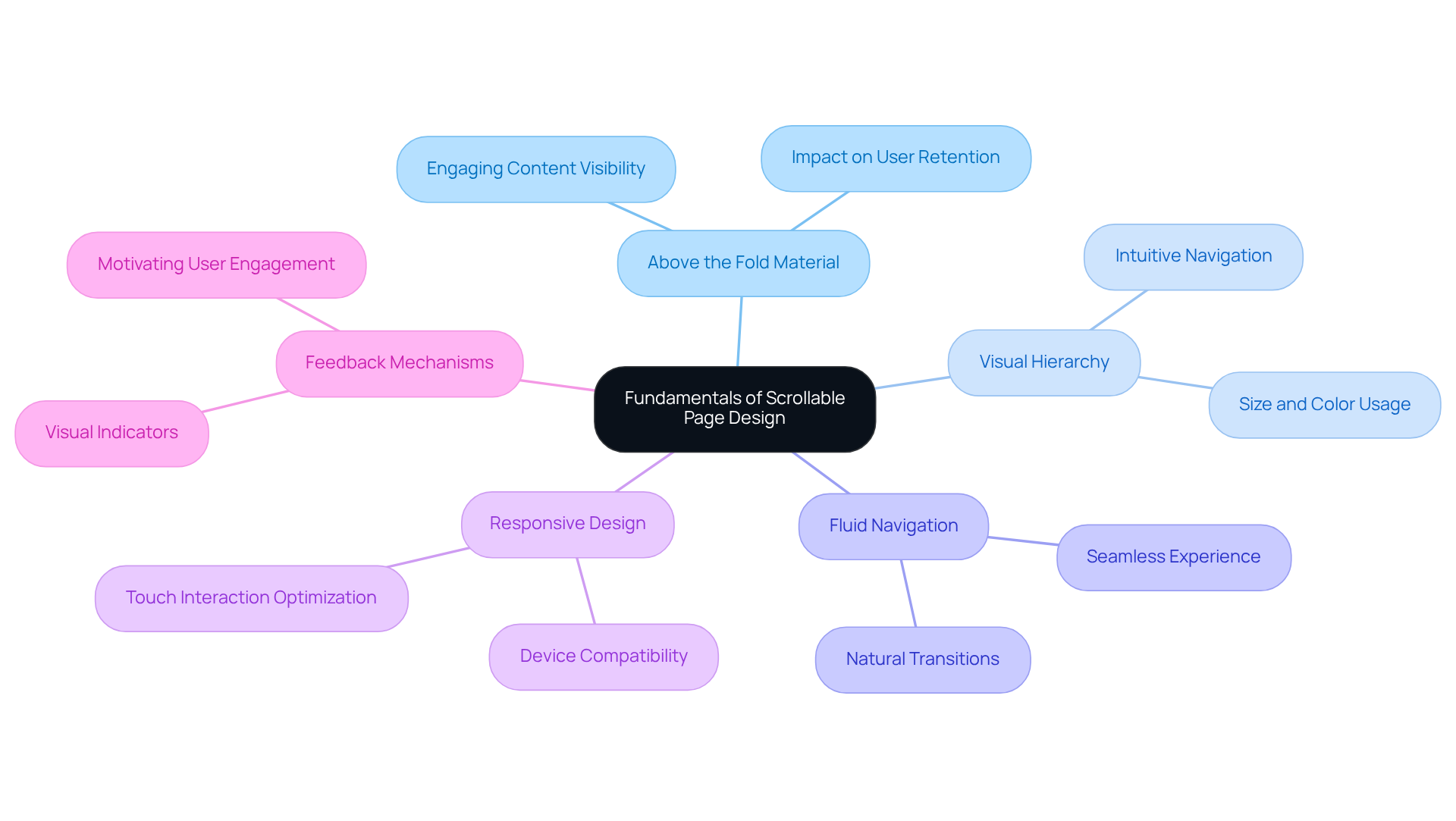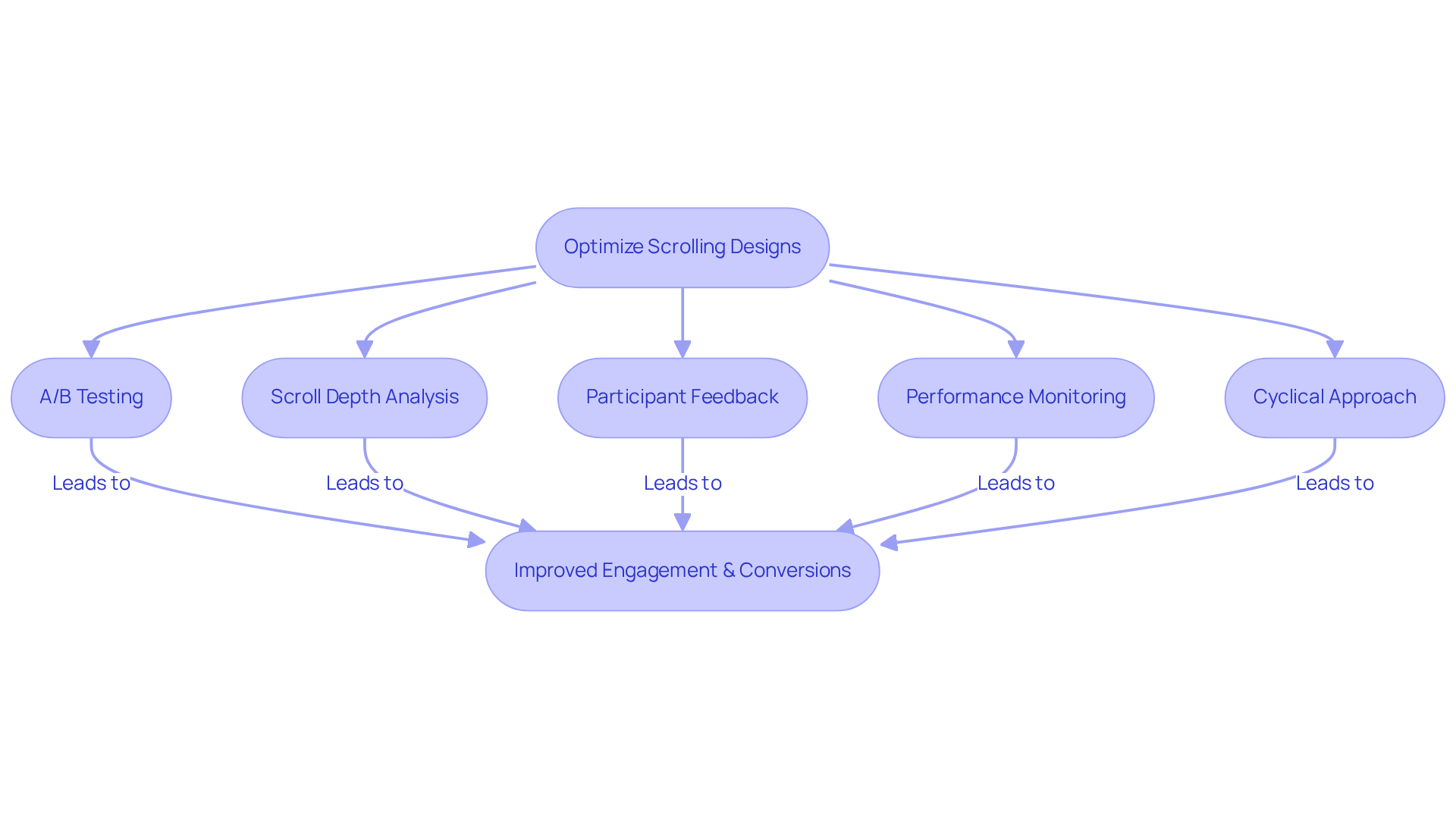
Overview
Mastering scrollable page design is not just a trend; it’s a necessity for enhancing user engagement and driving conversions. By focusing on key principles such as:
- Above-the-fold content
- Fluid navigation
- Interactive elements
businesses can create a seamless and captivating user experience. This approach encourages users to explore further and interact more deeply with web pages.
Above-the-fold content is crucial. It’s the first thing users see, and it must grab their attention immediately. Studies show that users are more likely to engage with content that is visible without scrolling. Therefore, placing essential information and calls to action in this prime real estate can significantly boost engagement rates.
Fluid navigation is another vital component. Users should be able to move through a site effortlessly. Complicated menus or confusing layouts can frustrate visitors, leading them to abandon the site. By ensuring that navigation is intuitive and straightforward, you enhance the likelihood of users staying longer and exploring more.
Interactive elements also play a key role in user engagement. Features like quizzes, polls, or interactive infographics not only capture attention but also encourage users to participate actively. This interaction fosters a deeper connection with the content, making users more likely to convert.
In conclusion, mastering scrollable page design is essential for any business looking to improve user engagement and conversions. By implementing these principles—focusing on above-the-fold content, ensuring fluid navigation, and incorporating interactive elements—you can create a web experience that captivates and retains users. Take action now to refine your web design strategy and watch your engagement metrics soar.
Introduction
In today's digital landscape, the design of web pages is crucial for capturing user attention and driving engagement. Scrollable page design, with its capacity to present content fluidly, presents a significant opportunity to enhance user experiences and increase conversion rates. Yet, the challenge lies in mastering the delicate balance of aesthetics, functionality, and interactivity.
How can designers effectively implement scrollable layouts that not only attract users but also keep them engaged throughout their journey? This question is at the heart of modern web design, where the stakes are high, and the competition is fierce. By understanding the principles of effective scrollable design, professionals can create experiences that resonate with users and lead to tangible results.
Understand the Fundamentals of Scrollable Page Design
Scrollable page design is anchored in several key principles that enhance user experience and engagement:
-
Above the Fold Material: The most engaging content must be visible without scrolling. This strategy captures attention immediately, prompting users to explore further.
-
Visual Hierarchy: Employ size, color, and placement strategically to guide users through the content. Important elements should stand out, facilitating intuitive navigation.
-
Fluid Navigation: Implement fluid navigation techniques to create a seamless experience. Easing effects can make transitions feel natural and engaging, enhancing user satisfaction.
-
Responsive Design: Navigation must function effectively across all devices. Mobile users, in particular, expect intuitive scrolling experiences on a scrollable page that is tailored for touch interactions.
-
Feedback Mechanisms: Visual indicators, such as arrows or subtle animations, should suggest that additional content lies beneath the fold. This motivates users to scroll further, enhancing engagement.

Implement Techniques to Encourage User Engagement
To enhance user engagement on scrollable pages, consider these powerful techniques:
-
Interactive Elements: Incorporate quizzes, polls, and interactive infographics that encourage participation. This transforms passive consumption into an engaging experience. In fact, interactive content can generate up to 52.6% more engagement compared to static alternatives, making it essential for modern web design.
-
Visual Storytelling: Utilize scrollytelling techniques to guide users through a narrative. This approach can include animations or transitions that reveal information as users scroll, creating an immersive experience that captivates attention. Remember, engaging storytelling must hook the audience within the first eight seconds to make a lasting impression.
-
Micro-Interactions: Implement subtle animations or feedback when users engage with elements on the page. For instance, buttons that change color or size upon hovering enhance the tactile feel of the interface, encouraging further exploration. Such micro-interactions can significantly boost satisfaction and retention rates.
-
Information Chunking: Divide content into digestible sections with clear headings and visuals. This strategy prevents overwhelming users and encourages them to scroll through the entire page. Users spend an average of 8.5 minutes on static material and 13 minutes on interactive elements, underscoring the importance of clarity in design to sustain interest.
-
Call-to-Action Placement: Strategically position calls to action (CTAs) throughout the scrollable content. Ensure they are visible and compelling, prompting users to take the next step. Effective CTAs can significantly enhance engagement and conversion rates, making them a crucial element of any scrollable page.

Test and Optimize Scrolling Designs for Better Performance
To maximize the effectiveness of a scrollable page design, it is crucial to implement targeted testing and optimization strategies that drive engagement and conversions. Here are key approaches:
-
A/B Testing: Regularly conduct A/B tests on various layout designs to identify which arrangements and features yield the highest engagement and conversion rates. Experiment with different placements of content, scrolling speeds, and visual cues to uncover the most effective combinations. Keep in mind that A/B testing is most impactful when there’s enough traffic to achieve statistically significant results.
-
Scroll Depth Analysis: Leverage analytics tools to track how far visitors scroll down your pages. This data is vital for pinpointing where interest wanes, allowing for targeted improvements in content and layout. Aim for a scrollable page depth of over 50% for general web pages and 75% or more for blogs to ensure that visitors are actively engaging with your material.
-
Participant Feedback: Gather qualitative insights from users about their scrolling experiences. Utilize surveys or usability assessments to uncover pain points and preferences, guiding necessary modifications. Engaging directly with users can provide invaluable insights that go beyond what A/B tests can reveal.
-
Performance Monitoring: Continuously evaluate the effectiveness of your dynamic layouts, focusing on load times and responsiveness. A slow or unresponsive experience can frustrate users, leading to higher bounce rates and diminished engagement. Ensure your layout interfaces are optimized for speed to maintain visitor interest.
-
Cyclical Approach: Embrace a cyclical strategy, making adjustments based on testing outcomes and user feedback. This approach ensures that the navigation experience evolves in line with user needs, ultimately enhancing engagement and conversion potential. However, be wary of over-testing, as it can lead to decision fatigue and hinder bold creative choices.
By implementing these strategies, you can anticipate improved user engagement and conversion rates, significantly enhancing the effectiveness of your scrolling designs.

Conclusion
Mastering scrollable page design is not just beneficial; it’s essential for enhancing user engagement and boosting conversion rates. By focusing on effective design principles—like above-the-fold content, visual hierarchy, and fluid navigation—websites can create inviting and intuitive experiences that encourage users to explore further. These foundational elements form the backbone of an engaging scrollable page, ensuring users remain captivated from the moment they arrive.
This article explores various techniques to elevate user engagement, including interactive elements, visual storytelling, and micro-interactions. By breaking content into manageable chunks and strategically placing calls to action, designers can guide users seamlessly through the experience. Testing and optimization are critical in this process, allowing for data-driven decisions that refine layouts and enhance performance. Through A/B testing, scroll depth analysis, and user feedback, designers can continually adapt to meet user needs and preferences.
Ultimately, the impact of scrollable page design on user engagement cannot be overstated. As digital interactions evolve, embracing these best practices will not only improve user satisfaction but also drive conversions. It is imperative for web designers and businesses alike to prioritize these strategies, ensuring that their scrollable pages are not just functional but also compelling—inviting users to engage deeply and take meaningful actions.
Frequently Asked Questions
What is scrollable page design?
Scrollable page design refers to a web design approach that enhances user experience and engagement by allowing users to scroll through content rather than navigating through multiple pages.
Why is "above the fold" material important in scrollable page design?
"Above the fold" material is crucial because it contains the most engaging content that is visible without scrolling, capturing users' attention immediately and encouraging them to explore further.
How does visual hierarchy contribute to scrollable page design?
Visual hierarchy helps guide users through the content by using size, color, and placement strategically, ensuring that important elements stand out and facilitating intuitive navigation.
What is fluid navigation and why is it important?
Fluid navigation involves implementing techniques that create a seamless experience for users. It enhances user satisfaction by making transitions feel natural and engaging.
Why is responsive design essential for scrollable pages?
Responsive design is essential because it ensures that navigation functions effectively across all devices, providing an intuitive scrolling experience, especially for mobile users who expect touch-friendly interactions.
What role do feedback mechanisms play in scrollable page design?
Feedback mechanisms, such as visual indicators like arrows or subtle animations, suggest that additional content lies beneath the fold, motivating users to scroll further and enhancing engagement.
FAQs











